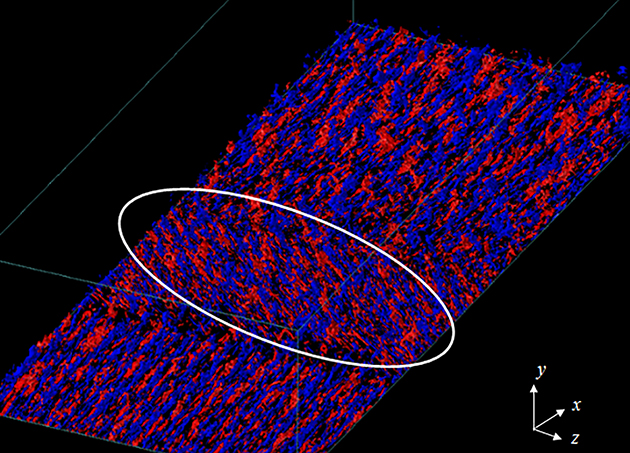Development of combustor simulation system based on physics understanding and modelling
JAXA Supercomputer System Annual Report April 2018-March 2019
Report Number: R18EDA201N06
Subject Category: Aeronautical Technology
- Responsible Representative: Yasuhiro Mizobuchi, Senior researcher, Aeronautical echnology Directrate, Numerical Simulation Research Unit
- Contact Information: Yasuhiro Mizobuchi(mizo@chofu.jaxa.jp)
- Members: Manabu Hisida, Taisuke Nambu, Hiroki Yao, Shogo Yasuda, Yasuhiro Mizobuchi, Hiroyuki Abe, Takeshi Okabe, Shingo Matsuyama, Mikiroh Motoe
Abstract
Development of simulation technology applicable to combustor design based on physics understanding and modelling by detailed and high-fidelity simulations
Reference URL
N/A
Reasons for using JSS2
World-level research in this field requires massively parallel huge computational resource and only so-called supercomputer system can provide it.
Achievements of the Year
A new analysis solver for incompressible two-phase flow, which is applicable to arbitrary shapes, was newly developed. Detailed numerical simulations including an inject nozzle were conducted.
A Eulerian spray analysis method was implemented on a flow solver based on a Cartesian grid. Flow through a fuel nozzle could be analyzed robustly by the present method.
A skewed turbulent boundary layer is one of the key phenomena in aeronautical applications such as combustors and airfoils. In the present study, we have performed a series of direct numerical simulations (DNSs) of a shear-driven three-dimensional turbulent boundary layer up to the momentum thickness Reynolds number Re_theta=900. The latter Re_theta is the largest Reynolds number ever performed in this configuration. Number of grid points used for Re_theta=900 are 1.5 billion to resolve the essential motions. Figure 3 shows visualization of tubulence structures for Re_theta = 900, which highlights the presence of hierarchical turbulence in the region where the cross flow is involved.
Fig.1(video): Shape of the interface.The color indicates the velocity magnitude on the interface.
Fig.2(video): Distributions of fuel concentration. (upper figure: Eulerian method, lower figure: Lagragian method).

Fig.3: Turbulence structures observed in the DNS for Re_theta=900 (blue: negative streamwise velocity fluctuation; red: positive streamwise velocity fluctuation).
Publications
– Peer-reviewed papers
1) Y. Mizobuchi, T. Nambu, T. Takeno, Numerical study of tip opening of hydrogen/air Bunsen flame, Proceedings of Combustion Institute 37 (2018).
2) H. Abe, Direct numerical simulation of a turbulent boundary layer with separation and reattachment over a range of Reynolds numbers, Fluid Dynamics Research, Special issue: Fluid Dynamics of Near-Wall Turbulence (2018).
3) H. Abe, R.A. Antonia and S. Toh, Large-scale structures in a turbulent channel flow with a minimal streamwise flow unit, J. Fluid Mech., Vol. 850, pp. 733-768 (2018).
– Oral Presentations
Hiroyuki Abe, Yasuhiro Mizobuchi and Yuichi Matsuo, Development of k-ε model using DNS data of a separated turbulent boundary layer, 50th FDC/36th ANSS, September, 2018.
HIroyuki Abe, DNS of a shear-driven three-dimensional turbulent boundary layer, Annual Meeting of JSFM 2018, September, 2018.
Hiroyuki Abe, Direct numerical simulation of a shear driven three-dimensional turbulent boundary layer, American Physical Society 71st Annual Meeting of the APS Division of Fluid Dynamics, Atlanta, GA, November 18-20, 2018.
Hiroyuki Abe, Yasuhiro Mizobuchi and Yuichi Matsuo, Development of k-ε model using DNS data of a separated turbulent flow, JSME Fluids Engineering Conference, November, 2018.
Taisuke Nambu, Yasuhiro Mizobuchi, Modeling of Liquid Fuel Atomization in a Cross-flow using Detailed Numerical Simulation, 27th Symposium (ILASS-Japan) on Atomization, December, 2018.
Yasuhiro Mizobuchi and Tadao Takeno, Investigation on Tip Opening phenomenon of hydrogen/air Bunsen flame by use of detailed numerical simulation -2nd report. Structure of flame tip-, 56th Symposium(Japanese) on Combustion, November, 2018.
Usage of JSS2
Computational Information
- Process Parallelization Methods: Both of MPI and XPFortran
- Thread Parallelization Methods: OpenMP
- Number of Processes: 8 – 384
- Elapsed Time per Case: 2000 Hour(s)
Resources Used
Fraction of Usage in Total Resources*1(%): 7.63
Details
Please refer to System Configuration of JSS2 for the system configuration and major specifications of JSS2.
| System Name | Amount of Core Time(core x hours) | Fraction of Usage*2(%) |
|---|---|---|
| SORA-MA | 71,104,265.04 | 8.71 |
| SORA-PP | 21,775.65 | 0.17 |
| SORA-LM | 9,213.20 | 4.30 |
| SORA-TPP | 0.00 | 0.00 |
| File System Name | Storage Assigned(GiB) | Fraction of Usage*2(%) |
|---|---|---|
| /home | 1,401.72 | 1.45 |
| /data | 32,413.27 | 0.57 |
| /ltmp | 5,180.43 | 0.44 |
| Archiver Name | Storage Used(TiB) | Fraction of Usage*2(%) |
|---|---|---|
| J-SPACE | 50.11 | 1.75 |
*1: Fraction of Usage in Total Resources: Weighted average of three resource types (Computing, File System, and Archiver).
*2: Fraction of Usage:Percentage of usage relative to each resource used in one year.
JAXA Supercomputer System Annual Report April 2018-March 2019


